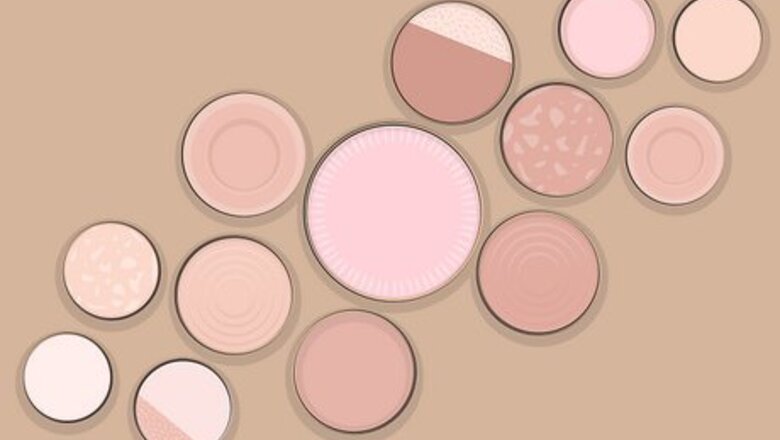
views
- Lay your platters out on a flat surface to figure out the design for your wall. Make templates by tracing the platters onto craft paper, and tape them to your wall.
- For disc plate hangers, wet the adhesive pad and stick it to the back of your platter. Attach picture hanging hooks or nails to your wall, and hang up your plates.
- For wire plate hangers, attach the hanger's hooks to the top and bottom of your platter. Use nails or picture hooks to secure your platter to the wall.
Arranging Your Plates & Platters

Lay out your platters on a flat surface to create your design. Take all of the platters and plates that you want to hang up and organize them by size and color. Start arranging your platters into different designs that fit the wall space where you want to hang them. Don’t be afraid to try a few different layouts to see what you like the best. When you’re happy with the final arrangement of your platters, take a picture so you remember how they were laid out. For a wall centerpiece, try placing a large platter in the middle of your design as a focal point. Then, arrange smaller plates around it. If you have a narrow wall space, create a vertical stack of plates that are all the same size. For a more striking design, use a large plate at the bottom of the stack and gradually smaller plates as you move up.
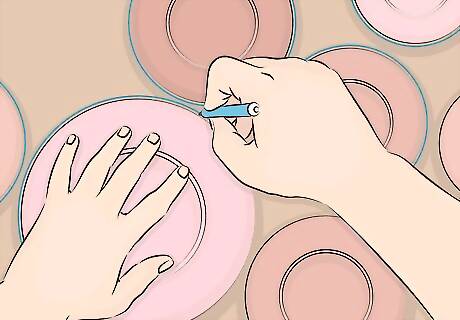
Trace your platters on craft paper and cut the templates out. Take your platters one at a time and set them upside-down on a piece of craft paper. Use a pencil to trace the outline of the plate. Then, use a pair of scissors to cut out the paper template of your platter. Trace and make templates for each of your plates on the design. Alternatively, cut out a large piece of craft paper that’s the same size as your wall space. Arrange your platters into a design and trace them all onto the same sheet. If some of your plates have a similar shape, make a label or write down a description of the platter on the paper template so you remember which one it’s for.
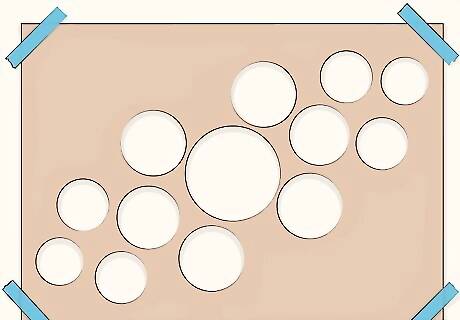
Tape the templates to your wall in the pattern you chose. Secure the templates to your wall with strips of painter's tape. Reference the picture you took of the layout and position the templates accordingly. Take a step back from your wall to get a better view of the layout, and make any final adjustments by moving the templates around until you’re satisfied with how they look. If you traced all your platters onto a large sheet of craft paper, tape up the entire sheet. That way, the templates are already in the correct position on your wall.
Using Disc Plate Hangers
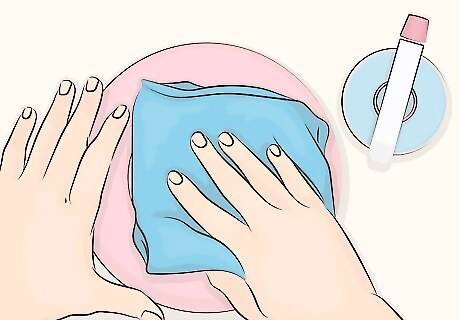
Clean and dry the backs of your platters. Wet a cloth with water or spray the back of the platters with glass cleaner and wipe them clean. Try to lift up as much dust or debris that’s stuck on the back of your dishes so the hangers can adhere to them better. Then, dry the platters off with another clean cloth. Forgetting to clean your platters could make the hanger less secure, meaning your plate is more likely to fall off.
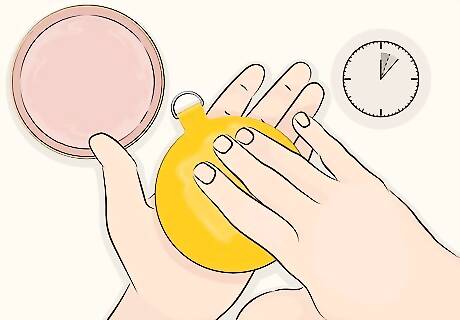
Wet the back of the disc hangers with water. Disc plate hangers have a hook on top and a circular adhesive pad that sticks directly to your platter. Choose disc hangers that are labeled to support the weight of your platters. Wet your fingers and rub them over the adhesive backing on the hangers. Wait about 3–7 minutes after wetting the hangers for the adhesive to feel tacky. Disc hangers work best if your platter has a flat surface on the back. If the dish has ridges or raised areas on the back, then choose a different hanging method. Avoid using Command hooks or strips to hang your plates since they may not support their weight.
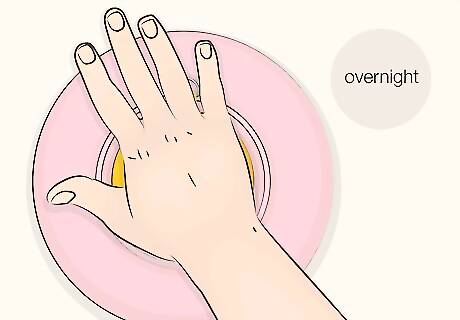
Press the hangers onto the backs of the platters and let them set overnight. Position your platters so the designs on the front are right-side up, and then flip them over. Position the hangers in the center of each plate and press them down firmly. Leave your platters overnight so the adhesive fully sets. Avoid hanging your platters on the wall right after attaching the disc hangers since they could fall off and break.
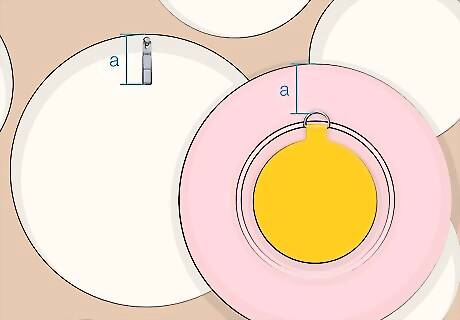
Attach picture hooks to your wall so they line up with the tops of the hangers. Measure the distance from the top of each platter to the top of the hanger’s hook. Transfer the measurements onto the paper templates attached to your wall. Use a hammer to secure a picture hook to each mark on your wall. Once you have all the hooks attached, rip down the paper templates since you don’t need them anymore. If you’re hanging a heavy platter on the wall, install a wall anchor to help support the additional weight. Use screws or screw-in picture hooks to hang your platters.

Hang your platters from the hooks on your wall. Simply line up the hook on the back of the hanger with the hook on your wall. Continue hanging up all of your platters to finish your wall design. If you ever want to use the platters you hung up, simply soak them in warm water to remove the adhesive hanger.
Using Wire Plate Hangers
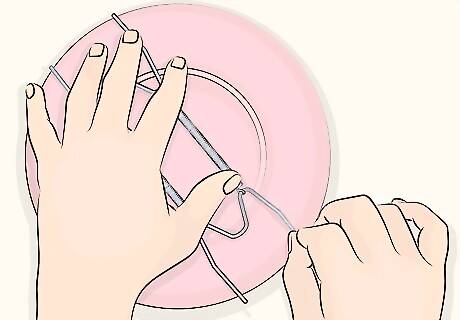
Hook wire plate hangers onto the backs of your platters. Wire picture hangers have 2 hooks connected by springs that clamp onto the back of your platters. Secure the top hooks to the top of the platter. Pull the bottom hooks down to stretch the springs, and secure them around the bottom lip of the dish. Add wire hangers to each of the platters that you want to display on your wall. Wire plate hangers work for any type of platter no matter the shape. If you want to protect a decorative platter from getting scratched by the wire hooks, choose vinyl hangers or hangers with plastic covers on the hook tips. Wire hangers come in different sizes, but tend to run small. You may need to select a hanger that's one size up to fit your plate securely.
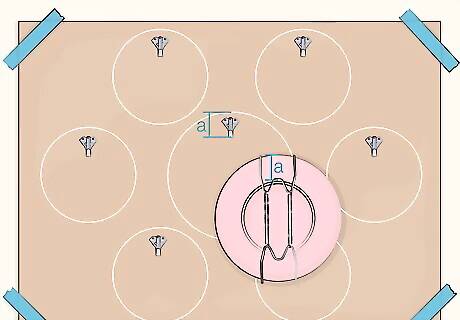
Add hooks or nails to your wall so they line up with the tops of the hangers. Look for the horizontal bar between the top hooks on the wire hanger. Measure the distance from the top of the bar to the top edge of the platter. Transfer the measurement onto the paper template for each platter. Drive a nail or picture hook through the template and into the wall to secure it. Once you have the nail or hook attached, pull the paper template off your wall. If you live in an area prone to earthquakes, choose picture hooks instead of nails since they make it less likely that your platters will fall off the wall.
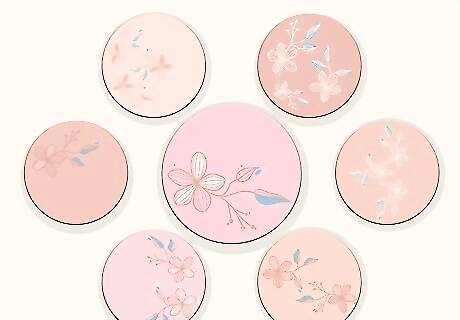
Set the hangers on the hooks or nails to display your platters. Carefully set the wire hanger’s bar onto the hook or nail on your wall. Continue hanging up the rest of your platters until you’ve completed the entire design on your wall.
Making DIY Plate Hangers
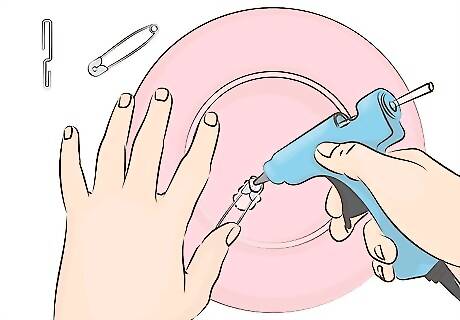
Hot glue a large safety pin or paper clip to the back of each platter. If you’re using a paper clip, unbend it so it looks like the letter S. If you’re using a safety pin, position the end that opens up on the bottom so the circular bit is pointed up. Coat the bottom half of the paper clip or safety pin with hot glue and press it firmly against the back of your platter. Let the glue dry completely. Avoid using small safety pins or paper clips since they won’t be able to support the weight of your platters. Alternatively, apply super glue for the most secure DIY hanger. Just be aware that you won’t be able to remove the clip or pin from your dishes as easily.

Glue a piece of felt to the bottom half of the pin or paper clip. Cut a circular piece of felt out that’s large enough to cover the bottom half of your pin or paper clip. Coat one side of the felt with hot glue and press it firmly against the back of your platter. Wait for the glue to completely dry, which should only take a few minutes. Hold the platter up by the pin or paper clip to ensure that it’s glued securely. If the platter feels like it’s slipping, then carefully peel off the felt, remove the glue with a plastic scraper, and try gluing it down again.

Add nails or hooks to your wall for each platter. Measure the distance between the top of the paper clip or pin and the top of the platter. Transfer your measurement onto the paper template attached to your wall so you know where to place your nail or hook. Use a hammer to drive a nail or picture hook into your wall on each of your marks before taking the templates down.
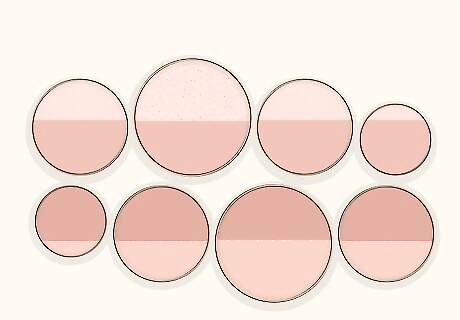
Hang up your platters to finish your design. Carefully position the clip or pin onto the nail or picture hook on your wall. Keep hanging the rest of your platters the same way until your design is finished on the wall.



















Comments
0 comment